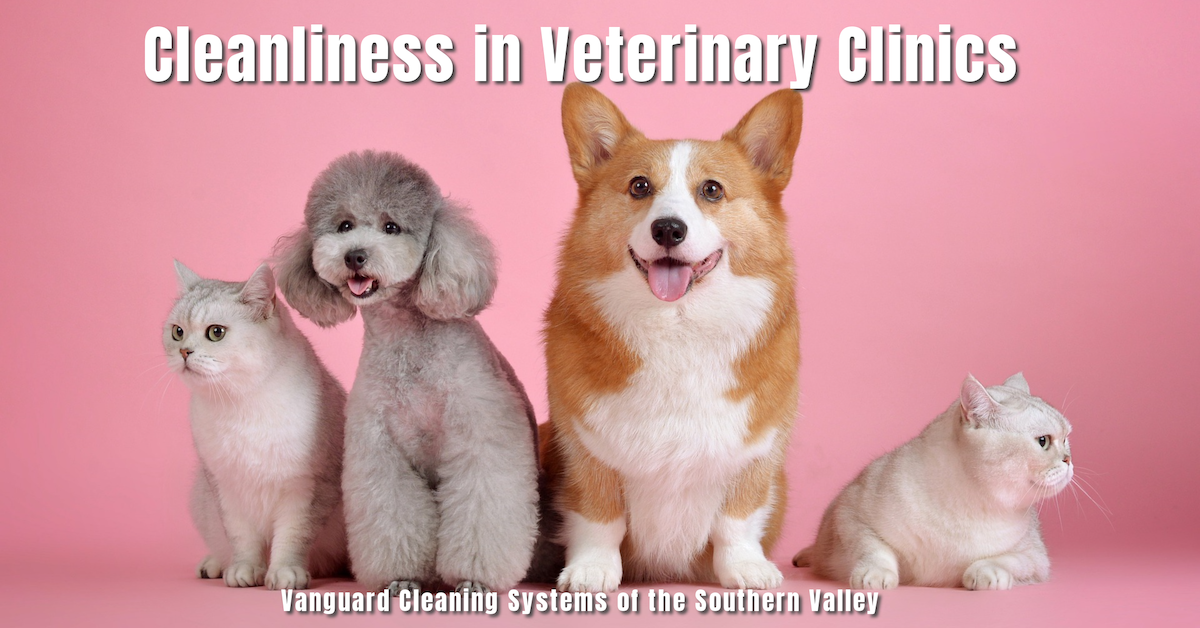Keeping a clean and hygienic environment is essential in veterinary clinics to prevent the spread of disease and infection, both among animals and between animals and humans.

The Importance of Infection Prevention and Control in a Veterinary Facility
Infection prevention and control are crucial in a veterinary facility to protect the health of animals, humans, and the environment for several reasons, including:
- Preventing the spread of infectious diseases: Veterinary facilities are high-risk areas for the spread of infectious diseases due to sick animals and animals carrying diseases. Strict infection prevention and control measures, such as proper cleaning and sanitization protocols, PPE use, and isolation of sick animals, are essential to prevent the spread of disease.
- Protecting staff and clients: Veterinary staff and clients risk contracting infectious diseases from animals or contaminated surfaces. Effective infection prevention and control measures help protect staff and clients from exposure to pathogens and reduce the risk of disease transmission.
- Ensuring high-quality care: Infection prevention and control are essential to high-quality veterinary care. By minimizing the risk of disease transmission, veterinary facilities can provide better outcomes for their patients and reduce the risk of treatment-related complications.
Veterinary Clinic Cleaning Challenges
Veterinary clinics face several health and hygiene challenges that require careful attention and management.
Some of the most common challenges include:
- Cross-contamination: The risk of cross-contamination is high in veterinary clinics because of the large number of animals that come in contact with each other and staff. It is essential to have strict cleaning and sanitization protocols to prevent the spread of infectious diseases between animals and from animals to humans.
- Waste management: Veterinary clinics generate significant waste, including biological waste and hazardous chemicals. Proper waste management is essential to prevent environmental contamination and the spread of infectious diseases.
- Occupational health: Veterinary staff may be at risk of occupational health hazards, such as exposure to infectious diseases, animal bites, and musculoskeletal injuries. Proper training and the use of PPE can help mitigate these risks.
- Allergies: Some staff members and clients may have allergies to animals or animal products. Veterinary clinics must take precautions to prevent exposure and minimize the risk of allergic reactions.
Zoonotic Diseases
Zoonotic diseases are infectious diseases that can be transmitted from animals to humans.
Some examples of zoonotic diseases include:
- Rabies.
- Lyme disease.
- Salmonellosis, and;
- Avian influenza.
Risks and Symptoms
Zoonotic diseases can be transmitted from animals to humans through direct contact with infected animals, their bodily fluids, or contaminated surfaces.
Some zoonotic diseases can also be transmitted through bites or scratches from infected animals.
Diseases can cause various symptoms in humans, including:
- Fever.
- Fatigue.
- Muscle aches.
- Problems breathing, and;
- Gastrointestinal issues.
Some zoonotic diseases can be severe or even life-threatening.
Prevention
There are several ways to prevent the transmission of zoonotic diseases, including:
- Practicing good hygiene, such as washing hands regularly and thoroughly with soap and water after handling animals or their environment.
- When handling animals or working in their environment, use personal protective equipment (PPE), such as gloves, masks, and gowns.
- Vaccinating animals against zoonotic diseases, such as rabies, reduces the risk of transmission to humans.
- Isolating animals with infectious diseases prevents disease from spreading to other animals or humans.
- Properly cleaning and sanitizing surfaces and equipment in veterinary facilities to prevent the spread of disease.
Takeaway
Veterinary clinics must adhere to strict cleaning and sanitization protocols to ensure the safety of their patients and staff.
These protocols include frequently cleaning exam rooms, treatment areas, kennels, and other high-touch surfaces with veterinary-grade disinfectants.
In addition to routine cleaning, veterinary clinics also follow specific protocols for infection control, such as using personal protective equipment (PPE) and isolating animals with contagious diseases.
Monitoring and testing surfaces and equipment for bacterial and viral contamination may also be necessary.
Maintaining a clean and hygienic facility is critical to providing quality veterinary care and protecting the health of animals and humans.
Onboarding and managing the requisite labor and material resources necessary to ensure the highest standards of cleanliness are achieved and maintained may prove cost-prohibitive for many organizations.
Outsourcing is a proven method for onboarding highly in-demand cleaning and sanitization services and experience for a fraction of the price of maintaining a similar service in-house.
If you would like more information regarding the effectiveness of high-performance infection prevention and control measures, or if you would like to schedule a free, no-obligation on-site assessment of your facility's custodial needs, contact us today for a free quote!
In Bakersfield, CA, call (661) 437-3253
In Fresno, CA, call (559) 206-1059
In Valencia, CA, or Santa Clarita, CA, call (661) 437-3253
In Palmdale, CA, or Lancaster, CA, call (661) 371-4756

